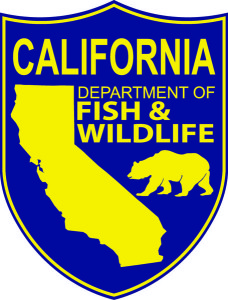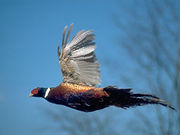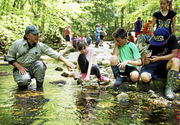California Department of Fish and Wildlife (CDFW)
An environmental summary created by the ENVS 560/L Watershed Systems class at CSUMB.

Contents
Overview
The California Department of Fish and Wildlife (CDFW) is a state agency under the California Natural Resources Agency. The Department of Fish and Wildlife manages and protects the state's fish, wildlife, plant and native habitats. CDFW divides the State of California into seven management regions and is responsible for managing recreational, commercial, scientific and educational uses. It also works to prevent illegal poaching.
History in California


The California Department of Fish and Wildlife (CDFW) has a long history in California: [1]
- Pre 1851 - Spanish and Mexican game and fish laws applied
- 1850s - California's first official fish and game laws established to protect species such as oysters elk, deer, salmon and quail. Game laws are extended to all counties in California
- 1860s - First closed seasons for trout fishing established
- 1870s - Board of Fish Commissioners is established, two of the first full-time game wardens are appointed, and the Fish Commission authority is expanded to include game
- 1885 - First California fish and game laws published.
- 1901 - Authority is expanded and game bag limits are set.
- 1909 - Name changed to Fish and Game Commission following a greater emphasis placed on game laws.
- 1913 - First year that fishing licenses are required. New law prevents sea otter take.
- 1920s - Reorganization of the Commission creates 3 new departments: fish culture, commercial fisheries, and patrol. Duties of the Fish and Game Commission taken over by the Division of Fish and Game (DFG).
- 1945 - A state constitutional amendment gives the Commission authority to make regulations for sport fishing and hunting.
- 1950s - Five regional offices established. New branches include: Bureaus of Game, Conservation, Inland Fisheries, Patrol and Marine Research. The Fish and Wildlife Coordination Act is enacted requiring consideration of DFG resources by state agencies when planning federal projects. Creation of The Water Projects Branch to monitor impacts of land use and water development projects on water quality.
- 1960s - DFG becomes part of the Resources of California agency. The Davis-Dolwig Act enables DFG to be more influential to the State Water Project planning. A DFG water quality laboratory approved by legislature to work on projects affecting fish and wildlife. Anadromous fish hatchery established.
- 1970s - The Endangered Species Act requires DFG to inventory the state's threatened or endangered species. Multiple species' populations are inventoried including sea otters and mountain lions. Drought in the late 1970s require DFG to rescue and relocate threatened fish species. DFG releases new deer management limits in response to state legislation enacted to manage deer herds.
- 1980s - CalTIP is created to enable citizens to report illegal taking of fish and game. DFGs wildlife education program begins to be taught in schools. An automated commercial fish tax system is started to monitor compliance. A randomized hunting tag system is started to divide up game tags distributed each year.
- 1990s - Aquaculture industry in California is placed first worldwide. First time a domesticated white sturgeon is spawned(federally listed). DFG becomes involved with oil spill response and prevention. Captive bred condors are released. DFG teams up with timber companies to restore fisheries and watershed resources. After the legislature passes the Marine Life Management Act, the DFG is required to set new commercial fishing regulations.
- 2013 - The California Department of Fish and Game changes its name to the California Department of Fish and Wildlife (CDFW) January 1, 2013 in order to better encompass changes to their responsibilities. Game wardens are now called wildlife officers.[2]
Management Responsibilities
Regulations and Permitting
- Recreational Fishing
- Commercial Fishing
- Hunting
- Game Breeding
- Fur Dealing
Outreach
- Education
Conservation
- Species Management
- Habitat Conservation
- Conservation Easements and Banks
- Environmental Review
- Cannabis Program
- 286 Protected Areas statewide
- 83 Wildlife Areas
- 102 Ecological Reserves
- 101 Marine Protected Areas
Recreational Fishing

CDFW is responsible for setting catch limits and publishing annual recreational fishing regulations. Separate regulations are available for ocean sport fishing [3], freshwater fishing [4], and sport fishing in Marine Protected Areas [5].
California Recreational Fisheries Surveys (CRFS) and Recreational Fisheries Data (recFIN)[6] are programs created to collect data on recreational fishing catches. This information is used to estimate catch rates and effort on a year-to-year basis, and can be used to update or change fishing regulations.
Commercial Fishing
CDFW issues the state's commercial fisherman with the proper licensing and permits needed to harvest within state waters. The department partners with multiple agencies, universities, stakeholders and fisherman to help monitor and regulate California's commercial fishing industry. By partnering with these groups, the CDFW has created a list of management programs and projects to protect and enhance California's ocean fisheries [7]. The CDFW enforcement division plays a key role in patrolling state waters and ensuring regulations are followed.
Hunting

Hunting regulations and laws are implemented and regulated by the CDFW. Each year a new list of regulations is created to keep hunters up to date with new hunting laws, restrictions and hunting seasons [8]. Hunting opportunities in the state are separated into categories:
- Small game - rabbit, coyote, squirrel, etc.
- Large game - deer, elk, bear, bighorn sheep, etc.
- Waterfowl - duck, geese and migratory game birds
- Upland birds - quail, pheasant, ruffed grouse, etc.
The agency also keeps track of all public and federal lands that are available to hunters, along with resources on all California game species [9]. CDFW manages multiple programs to help develop hunting opportunities and promote land management to enhance habitat for game species:
- Private Lands Management- This program provides incentives for landowners to manage their property for the benefit of wildlife, creating healthier populations of game species [10].
- Shared Habitat Alliance for Recreational Enhancement- CDFW partners with private landowners to provide access to private lands for hunters, incentivizing the landowners with payment and liability protection[11].
Education
Hunters Education Program
In 1954, California's first law requiring hunter safety courses was established [12]. Since then, CDFW requires all hunters to pass a hunter safety course that focuses on hunting regulations, firearm safety and responsible hunting.
Outreach
Classroom Aquarium Education Program[13] Also known as "Trout in the Classroom," this program introduces students to salmonids. Each classroom raises a batch of fish eggs while learning about salmonid ecology, aquatic habitats and fisheries management. The program ends with a field trip where the fingerlings are released.

California National Archery in the Schools Program[14]
Fishing in the City[15] Since 1993, CDFW has hosted fishing workshops in the metropolitan areas of Sacramento, San Francisco and Los Angeles. The program was developed to get people interested in fishing who may otherwise lack the skills necessary to enjoy fishing or be unaware of fishing opportunities in their communities.
California Fishing Passport program[16]Participants in this program are given a "fishing passport" and stamps to catch and check off more than 150 sport fish species while exploring the states many fishing locations.
Invasive Species[17] CDFW regularly updates lists of invasive species in the state and manages multiple online pages with information and resources on how to identify and stop the spread of invasive species.
Law Enforcement Division

CDFW law enforcement officers (Wildlife Officers) are tasked with a wide range of responsibilities. These duties include [18]:
- Enforcement of hunting and fishing laws
- Teaching and organizing hunter education programs
- Protecting waterways and natural habitats from:
- Pollution
- Illegal dumping
- Unregulated habitat destruction/alteration
- Responding to natural disasters
- Environmental Review and Permitting[19]
CDFW officers have the authority to enforce all federal fish and game laws, as well as all California laws [18]. CDFW Wildlife Officers responsibilities are separated into four districts:
- Northern Region
- North Coast Region
- Central Region
- Southern Region
Regional Divisions
The Department of Fish and Wildlife divides the State of California into seven management regions. The Marine Region includes the entire coastline of California. The six terrestrial regions are delimited by county boundaries with the exception of the North Central Region and Bay Delta Region (Sacramento, Yolo, and San Joaquin counties are split between the two).
- Northern Region: Del Norte, Humboldt, Lassen, Mendocino, Modoc, Shasta, Siskiyou, Tehama and Trinity counties.
- North Central Region: Alpine, Amador, Butte, Calaveras, Colusa, El Dorado, Glenn, Lake, Nevada, Placer, Plumas, Sacramento, San Joaquin, Sierra, Sutter, Yolo and Yuba counties.
- Bay Delta Region: Alameda, Contra Costa, Marin, Napa, Sacramento, San Mateo, Santa Clara, Santa Cruz, San Francisco, San Joaquin, Solano, Sonoma and Yolo counties.
- Central Region: Fresno, Kern, Kings, Madera, Mariposa, Merced, Monterey, San Benito, San Luis Obispo, Stanislaus, Tulare and Tuolumne counties.
- South Coast Region: Los Angeles, Orange, San Diego, Santa Barbara and Ventura counties.
- Inland Deserts Region: Imperial, Inyo, Mono, Riverside and San Bernardino counties.
CEQA Project involvement
In response to the January 1, 1970 passage of the National Environmental Policy Act (NEPA), the California Assembly created the Assembly Select Committee on Environmental Quality to study the possibility of supplementing NEPA on a state level. The California State Assembly passed the California Environmental Quality Act (CEQA) in 1970, giving the CDFW jurisdiction over conservation, wildlife management, native plants management, and maintaining habitat for to keep populations sustainable. CDFW provides the necessary expertise for environmental reviews and makes comments on potential project impacts.[20]. They charge a filing fee for preparing CEQA documents like environmental impact reviews, mitigated negative declarations and documents for pursing a Certified Regulatory Program to help offset the costs of managing the state's fish and wildlife resources.[21] The CDFW can fill the role of trustee agency, lead agency or responsible agency depending on the type of CEQA project being proposed.[22] They play the trustee agency role when providing the required biological expertise while reviewing project impacts and CEQA environmental documents, the lead agency role when they are responsible for enacting or approving projects, and the responsible agency role when decisions made by the lead agency will culminate in the issuance of a CDFW permit to prevent decision bias.
Conservation Easements
A conservation easement is a section of private land whose owner has voluntarily agreed to not develop in a legally binding agreement with a Native American tribe, government agency or non-profit organization. The CDFW regularly requires project permittees to supply compensatory mitigation when their work impacts or collects wildlife, plants and associated habitat.[23] One way for the permittees to provide permanent protection is to buy a conservation easement on someone's privately owned land or to purchase land themselves and place a conservation easement on it. They are then required to make sure their conservation easement meets all requirements outlined in California's SB 1094.[24] Permittees seeking to create compensatory mitigation are required to protect habitat of the highest quality available.[23] Requested conservation easement deeds are then sent to the CDFW. [25]
As of 2015, the CDFW officially held 202 easements totaling 63,263 acres, but due to under-reporting is thought to contain up to 156,000 acres. [26] In December 2016, CDFW awarded Proposition 1 funding to 4 Conservation Easement projects:[27]
- Indian Creek Conservation Easement - Lost Coast Redwood and Salmon Initiative Phase 2 – $1,400,00 granted to to Northcoast Regional Land Trust
- Marshall Ranch Conservation Easement – $5,012,125 granted to California Rangeland Trust
- Middle Branch of Russian Gulch – Forbearance Agreement/Conservation Easement - $400,000 granted to Sonoma Land Trust
- Paradise Cut Flood and Conservation Easement Acquisition - $2,035,000 granted to American Rivers
References
- ↑ Author unknown. 1999. Department of Fish and Game celebrates 130 years of serving California. Division of Fish and Game. [Cited April 2017]
- ↑ Traverso J. 2012. Department name change effective tomorrow. California Department of Fish and Wildlife. [Cited on 08 April 2017
- ↑ 2017-2018. Ocean Sport Fishing Regulations. California Department of Fish and Wildlife. [Cited April 2017]
- ↑ California Code of Regulation Title 14. 2017-2018. Freshwater Sport Fishing Regulations. California Department of Fish and Wildlife
- ↑ California's Marine Protected Area (MPA) Network. California Department of Fish and Wildlife. [Cited April 2017]
- ↑ Recreational Fishery Data (RecFIN). California Department of Fish and Wildlife. [Cited April 2017]
- ↑ Marine Life Management. California Department of Fish and Wildlife. [Cited April 2017]
- ↑ Fishing and Hunting Regulations. California Department of Fish and Wildlife. [Cited April 2017]
- ↑ Hunting in California. California Department of Fish and Wildlife. [Cited April 2017]
- ↑ Private Lands Management. Department of Fish and Wildlife. [Cited April 2017]
- ↑ Shared Habitat Alliance for Recreational Enhancement (SHARE). Department of Fish and Wildlife. [Cited April 2017]
- ↑ California Hunter Education. California Department of Fish and Wildlife. [Cited April 2017]
- ↑ Classroom Aquarium Education Program. California Department of Fish and Game. [Cited April 2017]
- ↑ California National Archery in the Schools Program. California Department of Fish and Wildlife. [Cited April 2017]
- ↑ Fishing in the City. California Department of Fish and Wildlife. [Cited April 2017]
- ↑ California Fishing Passport. California Department of Fish and Wildlife. [Cited April 2017]
- ↑ Invasive Species Program. California Department of Fish and Wildlife. [Cited April 2017]
- ↑ 18.0 18.1 Stoots C. 2016. CDFW NOW HIRING LAW ENFORCEMENT CADETS. California Department of Fish and Wildlife. [Cited April 2017]
- ↑ Environmental Review and Permitting. California Department of Fish and Wildlife. [Cited on 11 April 2017]
- ↑ Fish and Game Code Section 1802. California Department of Fish and Wildlife. [Cited on 11 April 2017]
- ↑ CEQA environmental document filing fees. California Department of Fish and Wildlife. [Cited on 12 April 2017.
- ↑ CDFW Role in CEQA. California Department of Fish and Wildlife. [Cited on 12 April 2017.
- ↑ 23.0 23.1 U.S. Bureau of Land Management and California Department of Fish and Wildlife. 2015. Agreement by and between the United States Bureau of Land Management and the California Department of Wildlife. [Cited on 11 April 2017]
- ↑ California Department of Fish and Wildlife. 2012. SB 1094 Mitigation Endowment Facts. [cited on 11 April 2017].
- ↑ California Department of Fish and Wildlife. 2010. Conservation easement deed application. [Cited on 11 April 2017]
- ↑ California Conservation Easement Database. 2015. California Conservation Easement Database Release Notice. [Cited on 13 April 2017]
- ↑ California Department of Fish and Wildlife. 2016. CDFW Awards $40 Million for Ecosystem and Watershed Restoration and Protection Projects. [Cited on 13 April 2017]
Links
- CDFW Logo
- Salwater Fisherman Picture
- Endangered Species Act
- federally listed
- Central Region Department of Fish and Wildlife
- Central Region Department of Fish and Wildlife
- California Natural Resources Agency
- Fish and Wildlife Coordination Act
- Davis-Dolwig Act
- Marine Life Management Act
- Marine Protected Areas
- CEQA projects on the Central Coast
- Agencies that are lead applicants in CEQA
- CEQA Overview
- Conservation Easement
- California Environmental Quality Act
Disclaimer
This page may contain student work completed as part of assigned coursework. It may not be accurate. It does not necessary reflect the opinion or policy of CSUMB, its staff, or students.